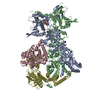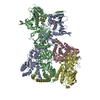+ データを開く
データを開く
- 基本情報
基本情報
| 登録情報 | データベース: PDB / ID: 8ffv | ||||||
|---|---|---|---|---|---|---|---|
| タイトル | Cryo-EM structure of the GR-Hsp90-FKBP52 complex | ||||||
 要素 要素 |
| ||||||
 キーワード キーワード | CHAPERONE / steroid hormone receptor / ligand binding / ATP binding / protein folding | ||||||
| 機能・相同性 |  機能・相同性情報 機能・相同性情報steroid hormone receptor complex assembly / negative regulation of microtubule polymerization or depolymerization / male sex differentiation / copper-dependent protein binding / Regulation of NPAS4 gene transcription / regulation of glucocorticoid biosynthetic process / nuclear glucocorticoid receptor activity / prostate gland development / steroid hormone binding / PTK6 Expression ...steroid hormone receptor complex assembly / negative regulation of microtubule polymerization or depolymerization / male sex differentiation / copper-dependent protein binding / Regulation of NPAS4 gene transcription / regulation of glucocorticoid biosynthetic process / nuclear glucocorticoid receptor activity / prostate gland development / steroid hormone binding / PTK6 Expression / neuroinflammatory response / copper ion transport / glucocorticoid metabolic process / nuclear glucocorticoid receptor binding / microglia differentiation / mammary gland duct morphogenesis / maternal behavior / protein-containing complex localization / astrocyte differentiation / cellular response to glucocorticoid stimulus / motor behavior / sperm mitochondrial sheath / dATP binding / Scavenging by Class F Receptors / sulfonylurea receptor binding / CTP binding / positive regulation of protein polymerization / vRNP Assembly / UTP binding / sperm plasma membrane / positive regulation of tau-protein kinase activity / negative regulation of microtubule polymerization / chaperone-mediated autophagy / telomerase holoenzyme complex assembly / regulation of gluconeogenesis / adrenal gland development / protein insertion into mitochondrial outer membrane / cellular response to steroid hormone stimulus / Respiratory syncytial virus genome replication / Rho GDP-dissociation inhibitor binding / Uptake and function of diphtheria toxin / FK506 binding / mitochondrial transport / Drug-mediated inhibition of ERBB2 signaling / Resistance of ERBB2 KD mutants to trastuzumab / Resistance of ERBB2 KD mutants to sapitinib / Resistance of ERBB2 KD mutants to tesevatinib / Resistance of ERBB2 KD mutants to neratinib / Resistance of ERBB2 KD mutants to osimertinib / Resistance of ERBB2 KD mutants to afatinib / Resistance of ERBB2 KD mutants to AEE788 / Resistance of ERBB2 KD mutants to lapatinib / Drug resistance in ERBB2 TMD/JMD mutants / PIWI-interacting RNA (piRNA) biogenesis / TPR domain binding / non-chaperonin molecular chaperone ATPase / Assembly and release of respiratory syncytial virus (RSV) virions / regulation of postsynaptic membrane neurotransmitter receptor levels / androgen receptor signaling pathway / dendritic growth cone / Sema3A PAK dependent Axon repulsion / regulation of protein ubiquitination / skeletal muscle contraction / HSF1-dependent transactivation / positive regulation of cell size / response to unfolded protein / telomere maintenance via telomerase / chaperone-mediated protein complex assembly / protein unfolding / HSF1 activation / regulation of protein-containing complex assembly / Attenuation phase / RHOBTB2 GTPase cycle / estrogen response element binding / FOXO-mediated transcription of oxidative stress, metabolic and neuronal genes / eNOS activation / axonal growth cone / positive regulation of lamellipodium assembly / DNA polymerase binding / chaperone-mediated protein folding / nuclear receptor-mediated steroid hormone signaling pathway / core promoter sequence-specific DNA binding / Tetrahydrobiopterin (BH4) synthesis, recycling, salvage and regulation / Loss of Nlp from mitotic centrosomes / Loss of proteins required for interphase microtubule organization from the centrosome / Recruitment of mitotic centrosome proteins and complexes / : / Signaling by ERBB2 / cardiac muscle cell apoptotic process / positive regulation of defense response to virus by host / cellular response to transforming growth factor beta stimulus / endocytic vesicle lumen / positive regulation of cardiac muscle contraction / Recruitment of NuMA to mitotic centrosomes / response to salt stress / Anchoring of the basal body to the plasma membrane / heat shock protein binding / HSP90 chaperone cycle for steroid hormone receptors (SHR) in the presence of ligand / TBP-class protein binding / activation of innate immune response 類似検索 - 分子機能 | ||||||
| 生物種 |  Homo sapiens (ヒト) Homo sapiens (ヒト) | ||||||
| 手法 | 電子顕微鏡法 / 単粒子再構成法 / クライオ電子顕微鏡法 / 解像度: 3.01 Å | ||||||
 データ登録者 データ登録者 | Noddings, C.M. / Agard, D.A. | ||||||
| 資金援助 |  米国, 1件 米国, 1件
| ||||||
 引用 引用 |  ジャーナル: Nat Struct Mol Biol / 年: 2023 ジャーナル: Nat Struct Mol Biol / 年: 2023タイトル: Cryo-EM reveals how Hsp90 and FKBP immunophilins co-regulate the glucocorticoid receptor. 著者: Chari M Noddings / Jill L Johnson / David A Agard /  要旨: Hsp90 is an essential molecular chaperone responsible for the folding and activation of hundreds of 'client' proteins, including the glucocorticoid receptor (GR). Previously, we revealed that Hsp70 ...Hsp90 is an essential molecular chaperone responsible for the folding and activation of hundreds of 'client' proteins, including the glucocorticoid receptor (GR). Previously, we revealed that Hsp70 and Hsp90 remodel the conformation of GR to regulate ligand binding, aided by co-chaperones. In vivo, the co-chaperones FKBP51 and FKBP52 antagonistically regulate GR activity, but a molecular understanding is lacking. Here we present a 3.01 Å cryogenic electron microscopy structure of the human GR:Hsp90:FKBP52 complex, revealing how FKBP52 integrates into the GR chaperone cycle and directly binds to the active client, potentiating GR activity in vitro and in vivo. We also present a 3.23 Å cryogenic electron microscopy structure of the human GR:Hsp90:FKBP51 complex, revealing how FKBP51 competes with FKBP52 for GR:Hsp90 binding and demonstrating how FKBP51 can act as a potent antagonist to FKBP52. Altogether, we demonstrate how FKBP51 and FKBP52 integrate into the GR chaperone cycle to advance GR to the next stage of maturation. | ||||||
| 履歴 |
|
- 構造の表示
構造の表示
| 構造ビューア | 分子:  Molmil Molmil Jmol/JSmol Jmol/JSmol |
|---|
- ダウンロードとリンク
ダウンロードとリンク
- ダウンロード
ダウンロード
| PDBx/mmCIF形式 |  8ffv.cif.gz 8ffv.cif.gz | 739.3 KB | 表示 |  PDBx/mmCIF形式 PDBx/mmCIF形式 |
|---|---|---|---|---|
| PDB形式 |  pdb8ffv.ent.gz pdb8ffv.ent.gz | 612.5 KB | 表示 |  PDB形式 PDB形式 |
| PDBx/mmJSON形式 |  8ffv.json.gz 8ffv.json.gz | ツリー表示 |  PDBx/mmJSON形式 PDBx/mmJSON形式 | |
| その他 |  その他のダウンロード その他のダウンロード |
-検証レポート
| 文書・要旨 |  8ffv_validation.pdf.gz 8ffv_validation.pdf.gz | 1.4 MB | 表示 |  wwPDB検証レポート wwPDB検証レポート |
|---|---|---|---|---|
| 文書・詳細版 |  8ffv_full_validation.pdf.gz 8ffv_full_validation.pdf.gz | 1.4 MB | 表示 | |
| XML形式データ |  8ffv_validation.xml.gz 8ffv_validation.xml.gz | 65.5 KB | 表示 | |
| CIF形式データ |  8ffv_validation.cif.gz 8ffv_validation.cif.gz | 99.4 KB | 表示 | |
| アーカイブディレクトリ |  https://data.pdbj.org/pub/pdb/validation_reports/ff/8ffv https://data.pdbj.org/pub/pdb/validation_reports/ff/8ffv ftp://data.pdbj.org/pub/pdb/validation_reports/ff/8ffv ftp://data.pdbj.org/pub/pdb/validation_reports/ff/8ffv | HTTPS FTP |
-関連構造データ
| 関連構造データ |  29068MC  8ffwC M: このデータのモデリングに利用したマップデータ C: 同じ文献を引用 ( |
|---|---|
| 類似構造データ | 類似検索 - 機能・相同性  F&H 検索 F&H 検索 |
- リンク
リンク
- 集合体
集合体
| 登録構造単位 | 
|
|---|---|
| 1 |
|
- 要素
要素
-タンパク質 , 3種, 4分子 ABCD
| #1: タンパク質 | 分子量: 84650.531 Da / 分子数: 2 / 由来タイプ: 組換発現 / 由来: (組換発現)  Homo sapiens (ヒト) / 遺伝子: HSP90AA1, HSP90A, HSPC1, HSPCA / プラスミド: pET151 / 発現宿主: Homo sapiens (ヒト) / 遺伝子: HSP90AA1, HSP90A, HSPC1, HSPCA / プラスミド: pET151 / 発現宿主:  参照: UniProt: P07900, non-chaperonin molecular chaperone ATPase #2: タンパク質 | | 分子量: 41198.973 Da / 分子数: 1 / Mutation: F602S / 由来タイプ: 組換発現 / 由来: (組換発現)  Homo sapiens (ヒト) / 遺伝子: NR3C1, GRL / 発現宿主: Homo sapiens (ヒト) / 遺伝子: NR3C1, GRL / 発現宿主:  #3: タンパク質 | | 分子量: 51876.520 Da / 分子数: 1 / 由来タイプ: 組換発現 / 由来: (組換発現)  Homo sapiens (ヒト) / 遺伝子: FKBP4, FKBP52 / 発現宿主: Homo sapiens (ヒト) / 遺伝子: FKBP4, FKBP52 / 発現宿主:  |
|---|
-非ポリマー , 3種, 5分子 




| #4: 化合物 | | #5: 化合物 | #6: 化合物 | ChemComp-DEX / | |
|---|
-詳細
| 研究の焦点であるリガンドがあるか | Y |
|---|
-実験情報
-実験
| 実験 | 手法: 電子顕微鏡法 |
|---|---|
| EM実験 | 試料の集合状態: PARTICLE / 3次元再構成法: 単粒子再構成法 |
- 試料調製
試料調製
| 構成要素 | 名称: Complex of the Glucocorticoid Receptor ligand binding domain, Hsp90 alpha dimer, and the co-chaperone FKBP52 タイプ: COMPLEX / Entity ID: #1-#3 / 由来: RECOMBINANT |
|---|---|
| 分子量 | 値: 0.307 MDa / 実験値: NO |
| 由来(天然) | 生物種:  Homo sapiens (ヒト) Homo sapiens (ヒト) |
| 由来(組換発現) | 生物種:  |
| 緩衝液 | pH: 7.5 |
| 試料 | 包埋: NO / シャドウイング: NO / 染色: NO / 凍結: YES |
| 試料支持 | グリッドの材料: COPPER / グリッドのサイズ: 400 divisions/in. / グリッドのタイプ: Quantifoil R1.2/1.3 |
| 急速凍結 | 装置: FEI VITROBOT MARK IV / 凍結剤: ETHANE / 湿度: 100 % / 凍結前の試料温度: 283 K |
- 電子顕微鏡撮影
電子顕微鏡撮影
| 実験機器 |  モデル: Titan Krios / 画像提供: FEI Company |
|---|---|
| 顕微鏡 | モデル: FEI TITAN KRIOS |
| 電子銃 | 電子線源:  FIELD EMISSION GUN / 加速電圧: 300 kV / 照射モード: FLOOD BEAM FIELD EMISSION GUN / 加速電圧: 300 kV / 照射モード: FLOOD BEAM |
| 電子レンズ | モード: BRIGHT FIELD / 倍率(公称値): 105000 X / 最大 デフォーカス(公称値): 2000 nm / 最小 デフォーカス(公称値): 800 nm / Cs: 2.7 mm / アライメント法: COMA FREE |
| 試料ホルダ | 凍結剤: NITROGEN 試料ホルダーモデル: FEI TITAN KRIOS AUTOGRID HOLDER |
| 撮影 | 平均露光時間: 5.9 sec. / 電子線照射量: 67 e/Å2 フィルム・検出器のモデル: GATAN K3 BIOQUANTUM (6k x 4k) 撮影したグリッド数: 1 / 実像数: 11162 |
| 電子光学装置 | エネルギーフィルター名称: GIF Bioquantum / エネルギーフィルタースリット幅: 20 eV |
- 解析
解析
| EMソフトウェア |
| ||||||||||||||||||||||||||||||||
|---|---|---|---|---|---|---|---|---|---|---|---|---|---|---|---|---|---|---|---|---|---|---|---|---|---|---|---|---|---|---|---|---|---|
| CTF補正 | タイプ: PHASE FLIPPING AND AMPLITUDE CORRECTION | ||||||||||||||||||||||||||||||||
| 3次元再構成 | 解像度: 3.01 Å / 解像度の算出法: FSC 0.143 CUT-OFF / 粒子像の数: 307109 / 対称性のタイプ: POINT | ||||||||||||||||||||||||||||||||
| 原子モデル構築 | 3D fitting-ID: 1 / Source name: PDB / タイプ: experimental model
|
 ムービー
ムービー コントローラー
コントローラー




 PDBj
PDBj





































